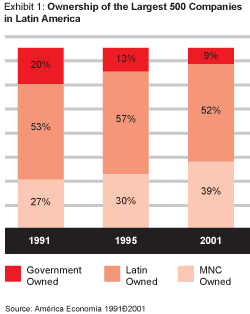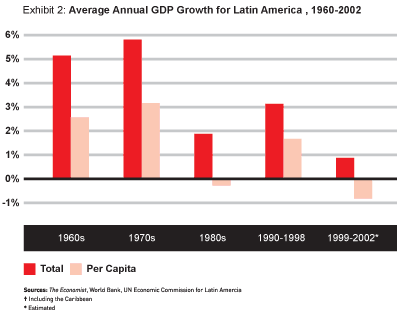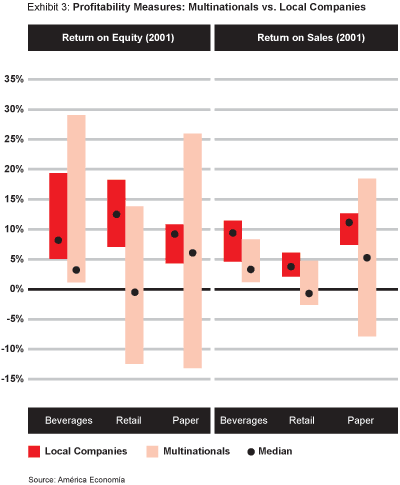Multinationals vs. Multilatinas: Latin America’s Great Race
Established global companies and emerging locals are battling for dominance. Here's how to handicap the winners.
A land of political and economic extremes, Latin America has long been among the world’s most challenging regions in which to do business. But corporations, some headquartered within the region and some outside it, have been undeterred, with many both fostering and profiting from Latin America’s vast market potential. Although a resurgence of disorder in such major markets as Argentina, Brazil, and Venezuela has recently dampened some companies’ regional ambitions, Latin America’s multinational moment remains ripe. Firms will only succeed, however, if they adjust their objectives to the territory’s real opportunities.
 |
|
Illustration by Robert Goldstrom |
Through the 1990s, foreign multinational corporations (MNCs) seemed unrelenting in their quest to invest in and conquer this culturally rich land of more than 500 million people, upwardly mobile consumers, and promising industrial markets. Between 1991 and 2001, the ownership of the 500 largest companies in Latin America changed dramatically, with non-Latin multinational ownership growing to 39 percent from 27 percent. (See Exhibit 1.) The rising foreign competition pressured local Latin companies, which historically served only their home-country markets, to consolidate and expand into other Latin American countries, transforming themselves into “multilatinas.”
 Some multilatinas are expanding within subregion free-trade areas, as defined by the Mercosur Pact (Brazil, Argentina, Uruguay, and Paraguay) or Andean Pact (Colombia, Venezuela, Ecuador, Peru, and Bolivia); others are growing panregionally — throughout Latin America. The most ambitious are aiming to compete with the world’s largest companies beyond Latin America. Brazilian multilatinas Gerdau, a steel conglomerate, and Embraer, a maker of small passenger jets, to take two examples, have acquired or built manufacturing assets in the United States, Europe, and Asia. However, to date few local Latin firms have taken on the world or tried to create large multilatinas. In fact, very few Latin American companies earn more than 50 percent of their revenue outside their domestic market.
Some multilatinas are expanding within subregion free-trade areas, as defined by the Mercosur Pact (Brazil, Argentina, Uruguay, and Paraguay) or Andean Pact (Colombia, Venezuela, Ecuador, Peru, and Bolivia); others are growing panregionally — throughout Latin America. The most ambitious are aiming to compete with the world’s largest companies beyond Latin America. Brazilian multilatinas Gerdau, a steel conglomerate, and Embraer, a maker of small passenger jets, to take two examples, have acquired or built manufacturing assets in the United States, Europe, and Asia. However, to date few local Latin firms have taken on the world or tried to create large multilatinas. In fact, very few Latin American companies earn more than 50 percent of their revenue outside their domestic market.
The post-2000 stock market collapse, currency devaluations, mounting political disorder, and the prospect of defaults on debt obligations have considerably reduced both the rate and the value of foreign investment in Latin America. In 2000, there were 166 merger and acquisition (M&A) deals initiated by MNCs, for a total value of $102.6 billion, according to Thomson Financial. In 2002, the total value of M&A activity by non-Latin companies was only $38.9 billion. Moreover, prompted by poor financial performance, some MNCs have been scaling back their Latin operations. In January, for example, the Bank of America Corporation disclosed plans to cut its 200-person Brazilian business by 75 percent, as part of a global reduction in its exposure to emerging markets.
Even though there are likely to be more rough times ahead, the long-term opportunities for business in Latin America are too great for corporations to ignore. The World Bank is forecasting improvement in the regional economy, with GDP for all of Latin America (including the Caribbean) projected to grow 2 percent in 2003 and 3.5 percent in 2004. And the “multinationalization” of businesses in Latin America is opening up new avenues for growth for all types of companies, although the needs and strategies of the MNCs and the multilatinas will, of necessity, differ.
We expect foreign MNCs to continue to gain overall share in Latin American markets in major consumer and industrial sectors, albeit at a slower pace than during the past two decades. To succeed, however, they will need to temper their purchasing of Latin American companies and create sustainable value from what they already own before making additional acquisitions.
Although slower foreign M&A activity will make it easier for the largest Latin American players to defend their turf, locals that choose to remain independent need to expand internationally, at a minimum across Latin America or in a subregion, to compete effectively against global MNCs, which have the size, growth, geographic breadth, and resilience to mitigate individual country risks.
The most competitive Latin American companies are motivated to become multinational so they can raise capital in foreign markets at favorable international rates and increase their liquidity. Few Latin firms are listed on the world’s leading stock exchanges, and those operating only in single countries are handicapped from doing international IPOs. Grupo Bimbo SA (Mexico’s largest packaged bread operation) and Carvajal SA of Colombia (which has a publishing and printing operation in every country from Mexico to Argentina, and recently expanded its “yellow pages” operation with the acquisition of Listel in Brazil) are among the multilatinas that are aggressively acquiring companies or entering into joint ventures to consolidate their positions across Latin America and move ahead of MNC competitors.
During the next decade, alliances, mergers, acquisitions, and managing intraregional competition among local and non-Latin companies will be critical components of corporate strategy in Latin America. Although MNCs still hold a lot of the competitive cards in most sectors, these traditional powerhouses from outside the region will have to learn new survival skills to live and thrive among the increasingly influential multilatinas.
The Multinational Boom
Multinationals have been building their positions in Latin America for decades in the automotive and pharmaceutical industries, and in such consumer product categories as tobacco and health and beauty aids. Beginning in the 1960s, British American Tobacco PLC (BAT) and Philip Morris Companies Inc. bought practically all the tobacco companies in their sector. Later, consumer giants Unilever PLC, Colgate-Palmolive Company, and Procter & Gamble Company took over most local health and beauty aid companies.
After the 1982 debt crisis, which started in Mexico and dried up foreign investment throughout the region, Latin America entered a period of economic decline that some have labeled the region’s lost decade. But by the late 1980s, there were signs of political change and economic improvements, first in Chile (fast growth there from 1987 to 1996 reduced poverty levels by 23 percent, according to the World Bank), and then in other Latin countries that instituted similar political reforms and supported growth and antipoverty agendas.
GDP and per capita income grew rapidly, as did the size of the middle- and low-income consumer groups that are so critical to the growth of global and local companies. (See Exhibit 2.) After years of military dictatorship, democracy became well established. Other liberal economic programs, including privatization, deregulation of key industries, and tariff reductions, also prevailed. Privatization of state-owned industries opened entire sectors — telecommunications, electric utilities, oil — to local and foreign investors. Concurrently, economic integration and trade accords, including the Mercosur and Andean pacts and the North American Free Trade Agreement (NAFTA), created regional markets that stimulated trade and investment flows. The regional trade pacts made it feasible for the first time for companies in Latin America to coordinate operations in adjacent countries to achieve economies of scale and scope. Foreign MNCs now had real incentives to grow their subregional and panregional operations, and local companies could now go regional.

A Second Surge
Stimulated by liberal economic policy and the boom in capital markets, Latin America experienced a second “multinationalization” surge in the 1990s. This happened in several waves, sector by sector, as major foreign players acquired companies and then consolidated their positions across the region. Three types of events triggered these industrial buying booms:
- Privatization of State-Owned Industries. From 1991 to 2000, state-owned enterprises’ share of the top 500 companies’ sales declined by 10 percent, while the multinationals’ share increased by 13 percent. Although most of the prime candidates have already been privatized, the trend has continued; for example, the Spanish energy company Repsol became one of the world’s biggest oil firms when it bought Argentina’s state-owned YPF to form Repsol YPF in 2002.
- Battles for Regional Dominance among Global MNCs. For instance, over a 10-year period, Spain’s two largest banks, Banco Santander Central Hispano SA (BSCH) and Banco Bilbao Vizcaya Argentaria SA (BBVA), snapped up banks to become leaders in every major market in Latin America. Sometimes global competitors have used Latin America as a battleground to win global dominance in an industry. Nestlé SA and Unilever, seeking worldwide domination of the ice cream category, acquired most of the large local Latin American companies in the sector in only a few years.
- MNC-Led Industry Transformations. Such sectors as retailing, in which the rules of competition are changing quickly, proved ripe for acquisitions and alliances. New entrants from outside Latin America overwhelmed local companies. U.S. giant Wal-Mart Stores Inc. rapidly gained leadership in Mexico and has expanded southward, while global retailers of European origin — Makro NV of the Netherlands and France’s Carrefour SA — started in Brazil and Argentina and are moving north. All are formidable competitors.
The fact that local owners wanted to sell abetted the MNC buying spree of the 1990s. Worn out by decades of economic instability and government upheavals, local companies faced increasingly stiff competition from global brands. Many were servicing expensive debt, yet needed more capital to upgrade their infrastructures. Second- or third-generation family members, in numerous cases, no longer had close ties to their businesses, and preferred to cash out to obtain liquid assets.
The Multilatinas’ Turn
Locals have acutely felt the disadvantages of size, financing access, and costs. During the 1990s boom, few local companies had the capacity to battle MNCs for prime acquisitions; most of their transactions were within their home countries. Brazil’s largest retailer, Companhia Brasileira de Distribuição SA (CBD), acquired several smaller Brazilian chains, and Almacenes Exito SA (Exito), the largest retailer in Colombia, merged with its leading competitor there, Cadenalco.
Upon securing top positions at home, some of these local leaders aspired to grow internationally. Typically, a budding multilatina would begin that process by exporting to neighboring countries; then it would establish alliances to obtain access to distribution channels. Subsequently, a company might set up small operations or make small acquisitions.
Today, a strong case can be made that in the next few years, multilatinas will become even more vigorous in their pursuit of international expansion and consolidation; some will become formidable challengers to foreign MNCs. Global candy and food companies such as Kraft Foods and Nestlé still compete against strong single-country players and such emerging multilatinas as Mexico’s Bimbo; the confectioner and food company Grupo Arcor, which is headquartered in Argentina; and Compañía Nacional de Chocolates and InverAlimenticias Noel SA in Colombia. In retail banking, leading local companies such as Banco Bradesco SA and Banco Itaú in Brazil compete with Citibank and ABN AMRO, two of the world’s largest and most powerful global banks.
Clearly, with the decline of the world economy and global stock markets, MNCs have lost some of their advantage. The lackluster Latin economy hasn’t helped; regional GDP contracted by 0.6 percent in 2000 and grew less than 1 percent in 2001. Spain’s BSCH and the U.S.’s Clorox and BellSouth corporations, for example, all cited disappointing results in Latin America in 2002. Many major foreign companies that acquired aggressively in the region during the 1990s are acknowledging they did not generate enough growth in revenue and earnings to justify the large premiums they paid.
Leading local players have stepped into the vacuum. In the beer industry, a locals-led consolidation battle is brewing, with Brazil’s Companhia de Bebidas das Américas (Ambev) acquiring control of Quilmes SA in Argentina in January 2003, and Colombia’s Bavaria SA acquiring several Panamanian breweries and then struggling to gain control of the Backus Corporation in Peru (in which Venezuela’s largest brewer, Cervecería Polar, already had a share). Such global beer giants as Anheuser Busch Companies, Heineken NV, and Interbrew NV, despite their minority stakes in several breweries in the region, have remained aloof. Further consolidation among Latin America’s largest brewers could create a company comparable in size and profits to the world’s top beer companies.
Indeed, the continuing liveliness of Latin M&A activity today is largely a function of domestic consolidations and cross-border unions among Latin companies. Three years ago, non-Latin companies accounted for more than 80 percent of the region’s deals. Since the beginning of 2003, locals have accounted for 62.5 percent of all M&A activity in the region, spending $6.5 billion on other Latin American enterprises, according to Thomson Financial.
Economic uncertainty always makes foreigners wary, so it is conceivable that the volatility will prompt some global multinationals to pull back permanently from the region. Latin companies appear to be exploiting the uncertainty by repositioning themselves against foreign rivals. For example, Mexico’s América Móvil SA has been acquiring companies in Brazil and Colombia from BellSouth, which has been divesting holdings in the region. In the financial-services sector, earlier this year Brazil’s largest privately owned bank, Banco Bradesco, bought J.P. Morgan Chase’s asset management division, and also acquired the local asset management operations of Spain’s BBV and Deutsche Bank. Rival Banco Itaú bought Banco BBA-Creditanstalt SA from the HVB Group of Germany in 2002 after acquiring the private banking and asset management units of the U.K.’s Lloyds TSB Bank PLC in 2001.
Capturing Network Value
If non-Latin MNCs find themselves at a temporary stall, it’s because their acquisitive zeal did not translate easily into profitability. As much as executives try to attribute their woes to unfavorable economic conditions, that has not been the only cause; managerial missteps, even arrogance, have played a role. Most foreign acquirers underestimated how difficult it is to absorb companies in different countries and create synergies among them.
Non-Latin entrants also underestimate the challenge of serving the typical Latin American mass-market consumer profitably.
On average, MNCs’ Latin operations over the past few years have been less profitable than local competitors’ operations. (See Exhibit 3.) Why does this happen? When an MNC quickly pushes an acquisition into a cross-border organization, it risks destroying the unique value that made the company attractive in the first place. Major sources of intangible value — local brands, price points geared to the low-income mass market, tailored distribution systems, and management practices that recognize each market’s economic and cultural peculiarities — may be lost when a multinational alters the local business model and operations.

An acquired company’s returns almost always fall in the first year, because costs go up. With a more expensive and less experienced expatriate typically running the operation, wages and salaries grow, response times slow, and overhead balloons. Foreign MNCs also suffer when they try to increase market penetration of global brands by displacing or minimizing promotion of a popular local brand.
In the long run, MNCs can generate value in Latin acquisitions in two ways: by increasing productivity and by capturing synergies. The first tactic, though, merely allows a company to operate at parity with its local competitors. Successful local companies, especially leaders with access to world-class best practices and technology through their relationships with global consultancies and equipment vendors, or through alliances, tend to operate quite efficiently, setting a high bar for MNC newcomers. Many independent local companies have results that global players in their industries would envy. In 2002, 17 Latin American companies — eight in food and beverages/beer — had return on equity of 10 percent or better. Even in embattled industries, such as airlines and steel, there are Latin American companies, such as Lan Chile (the Chilean airline), Copa Airlines (the Panamanian airline), and Gerdau, that have world-class operating practices and are globally competitive.
Acquisition strategies to capture synergies among companies must take shape long before individual acquisitions are targeted; MNCs need to plan to build network scale. Their aim must be more than building market share country by country; they should seek to meld complementary operational capabilities that can be exploited across several countries or the entire region. In production, network scale is critical. Instead of having redundant factories in each country, a corporation can use a single factory to serve several markets. In marketing, too, companies can exploit network scale by creating pan-Latin brands that attract customers across multiple markets. MNCs can also achieve overhead efficiencies by building a shared-services infrastructure for business management functions such as finance and human resources. Most MNCs building network scale try first to improve performance of acquired stand-alone operations, then develop networks within subregional clusters (e.g., the Andean region, Mercosur, or Central America). This is followed by more expansive pan-Latin integration, and finally a stage in which they are managing the Latin American market as a whole.
Global companies that have been operating profitably in Latin America for years often started as a collection of individual companies. This was the strategy of BAT in tobacco, which produces and markets predominantly local brands. Over time, as it developed global brands and pursued global sourcing, BAT’s operations were integrated. Pfizer Inc. and Unilever manage Latin America in regional clusters, although some functions, such as sourcing, have regional or global management. MNCs addressing Latin America as a single (or nearly single) market use shared services, competency centers, category management, and integrated sourcing across the entire region. Procter & Gamble is the leader in developing this management model.
Companies operating in Latin America at the “ single-market” level can leverage the Internet, other information technologies, and flexible cross-border organizational models to achieve economies of scale and flexible local market response that equal what’s possible in the United States or Europe. Most multinationals operating in Latin America have not achieved the most advanced stages of network integration, even though they face greater pressure today to do so (and quickly), especially if they’re making multiple acquisitions and have not achieved good results.
Low-Income Opportunities
Developing new products and business models for low-income and middle-class segments, which comprise about 245 million people or roughly 50 percent of the total population, is a major growth opportunity for MNCs and multilatinas alike. But serving this market profitably is hard, especially for non-Latin companies. A mass consumer in Latin America earns a fraction of the income of the average consumer in developed markets. He or she does not have a car, typically can’t afford to make impulse purchases of small items (even a whole candy bar), and would not, in a developed country, qualify to open a bank account or have a credit card. Yet as a group, these consumers have massive purchasing power and a strong desire to buy basic goods and services.
To sell and distribute profitably to this mass market requires capabilities that MNCs often lack. We have seen many MNCs, particularly consumer goods companies that have tried to import their upscale global brands and distribution models from retail markets in developed countries, struggle in Latin America. For example, Unilever’s acquisition of Varela SA, a Colombian home and personal care company, and Best Food’s acquisition of the Brazilian food company Arisco faced a similar difficulty: the integration of local companies that made popular low-priced brands into firms accustomed to producing and selling more expensive products. In both cases, the result was that these companies lost a considerable portion of their market share, or divested parts of the acquired businesses.
Global MNCs frequently face trouble managing distribution channels in Latin America. Most of the region’s distribution channels are small stores, especially in categories such as food, packaged goods, and construction materials, and they differ markedly from the concentrated distribution environments in Europe and the United States.
Large Latin locals have also done better than foreign competitors in selling to low-income consumers, because they tend to create products and services suited for them. Locals also have distribution channels in place to make these products broadly accessible and business models that allow them to do so profitably. Whereas the U.S. chocolate companies Mars Inc. and the Hershey Foods Corporation have established only a marginal presence in Latin America by selling their larger chocolate bars, Arcor and Nacional de Chocolates have developed sizable businesses selling bite-sized chocolates that are affordable to low-income consumers, cater to their tastes, and can be bought in remote rural stores.
Banks such as Bradesco in Brazil and Banco Caja Social in Colombia are able to offer services to low-income households many other banks would not serve; they’re also among the most profitable banks in their countries. Grupo Maseca SA in Mexico and Polar in Venezuela have grown to be among the largest and most successful food companies in Latin America by producing tortillas and flour for “arepas,” which is a basic food staple, and by making them available in the small retail stores where low-income consumers typically shop.
How Multilatinas Will Multiply
Expanding internationally is clearly the other critical growth strategy for Latin American companies, especially the rising Brazilian and Mexican multilatinas that have been able to prosper in their large single-country markets. Although locals are under pressure to become at least panregional in scope, they must carefully examine many issues as they develop their strategy. They should:
- Recognize when multicountry scale is appropriate, and understand how it will affect the business.
- Define the minimum scale and coverage necessary to compete in their sector (e.g., subregional, pan-Latin, or even global).
- Achieve scale through a combination of domestic consolidation and regional acquisitions and alliances.
Locals can derive multicountry scale and management networks in several ways, and through a combination of strategies: They can build on language and cultural similarities to develop pan-Latin brands; concentrate on easily transportable products with high economies of scale in production; use fewer and larger plants sourcing in more countries; and establish service centers in low-cost countries or develop services through the Internet.
Ultimately, the decisions for local companies — and their fates — revolve around four variables: the degree of scale required in their sectors; the presence and eminence of multinationals aggressively building pan-Latin positions; the desire of the current shareholders to remain in the business; and their willingness to share control.
A few Latin American companies have begun to compete globally. For example, Cemex SA de CV has grown from a Mexican conglomerate to become one of the most successful cement companies in the world. Of course, some sectors are more globally scalable than others. The pharmaceutical and automotive industries require massive investments and are fated to be dominated by global players. Yet the construction materials industry will probably remain dominated by locals, because the building products used in the region differ markedly from those used elsewhere. Corporate banking increasingly requires global scale, but retail banking can be more local.
Scenarios for the future depend largely on the pace at which multinationals continue taking over different sectors, and the degree to which the leading locals rise to the challenge of becoming viable pan-Latin competitors. Brazilian and Mexican multilatinas will almost certainly become a significant force to be reckoned with. Brazilian companies, which have formidable positions and vast market potential at home, headed abroad initially by developing or acquiring companies in neighboring Argentina, although many were burned in the process. A recent Booz Allen Hamilton study of the multinational strategies of Brazilian companies revealed that, after a decade of domestic market liberalization and industrial transformation, leading Brazilian firms are now focusing on international growth. As companies begin their internationalization process and diversify their risks, they tend to increase their access to capital, and do so at a lower cost. Indeed, the study suggests that Brazilian CEOs understand they have no choice but to expand internationally to become more attractive to international investors, and to lower the country risk premium they pay above MNC competitors.
How Mexican companies play their cards depends on whether they decide to capitalize on NAFTA to develop a position in the U.S. market, or expand toward Central and South America, leveraging the cultural and market affinities together with their relative size advantage. Several companies have discovered that they can apply the investment and effort required to develop a small presence in the U.S. to buy or build a leading position in most Spanish-speaking Latin American markets.
The Ideal Scenario
Recent political and economic problems in Latin America have resulted in sizable stumbling blocks to market integration. The collapse of the Argentine economy has hurt the Mercosur Pact. Political volatility in Venezuela and security concerns in Colombia remain hurdles to trade and to the stability of the relationship between the two largest countries in the Andean Pact. In the next 10 years, the economies of Latin America are not going to grow significantly, and political and economic turbulence will continue. And even though Mexico and Chile today are more stable, a crisis could come unexpectedly.
None of this will prevent continued Latin American market integration and the “multinationalization” of the business landscape. It is inevitable, and it is the best path: No other group of emerging market countries has so much in common. Latin American countries largely share a Spanish language and heritage; the Portuguese language and heritage are close enough to allow Brazilians and their neighbors to communicate easily. The Southern Florida melting pot, where Latin Americans of all nationalities mix easily in a blend of Hispanic cultures, is a picture of what Latin America itself can be. Tapping into the region’s cultural affinities through the network scale approach is the right competitive strategy.
Furthermore, the growing middle class, and the ambitions of the increasingly literate lower class, will fuel demand for better living standards, services, and products. The large untapped market of low-income consumers in all countries, and upwardly mobile prospects, is attractive to foreign multinationals, and even more so to local companies.
To achieve steadier and healthier development, countries should encourage balanced foreign and local investment. This will not be easy, however. MNCs have historically invested in the region’s key economies at different rates. The ideal scenario for Latin America is strong global MNCs’ continuing to invest and strengthen the local economies through their profitable operations. At the same time, the region should support the expansion of a class of thriving multilatinas with the vision and courage to replicate and adapt their successful home-country models across Latin America. ![]()
Reprint No. 03307
Alonso Martinez (martinez_alonso@bah.com), a vice president of Booz Allen Hamilton based in Miami, Fla., works throughout Latin America with multinational and leading Latin companies, particularly in the consumer products, media, and construction industries. Mr. Martinez advises companies on strategic repositioning and operational effectiveness.
Ivan De Souza (de_souza_ivan@bah.com) is a vice president of Booz Allen Hamilton in São Paulo, Brazil. He advises conglomerates and financial-services companies in business portfolio strategy, organization effectiveness, and transformation.
Francis Liu (liu_francis@bah.com) is a vice president of Booz Allen Hamilton in São Paulo, Brazil. He is head of the firm’s Latin America consumer goods and retail group, and has also worked with media companies.
Also contributing to this article were José Gregorio Baquero (baquero_jose_gregorio@bah.com), a vice president of Booz Allen Hamilton in Caracas, Venezuela, and Maria Christina Duarte (duarte_maria_christina@bah.com), a Booz Allen senior associate in Miami, Fla.


